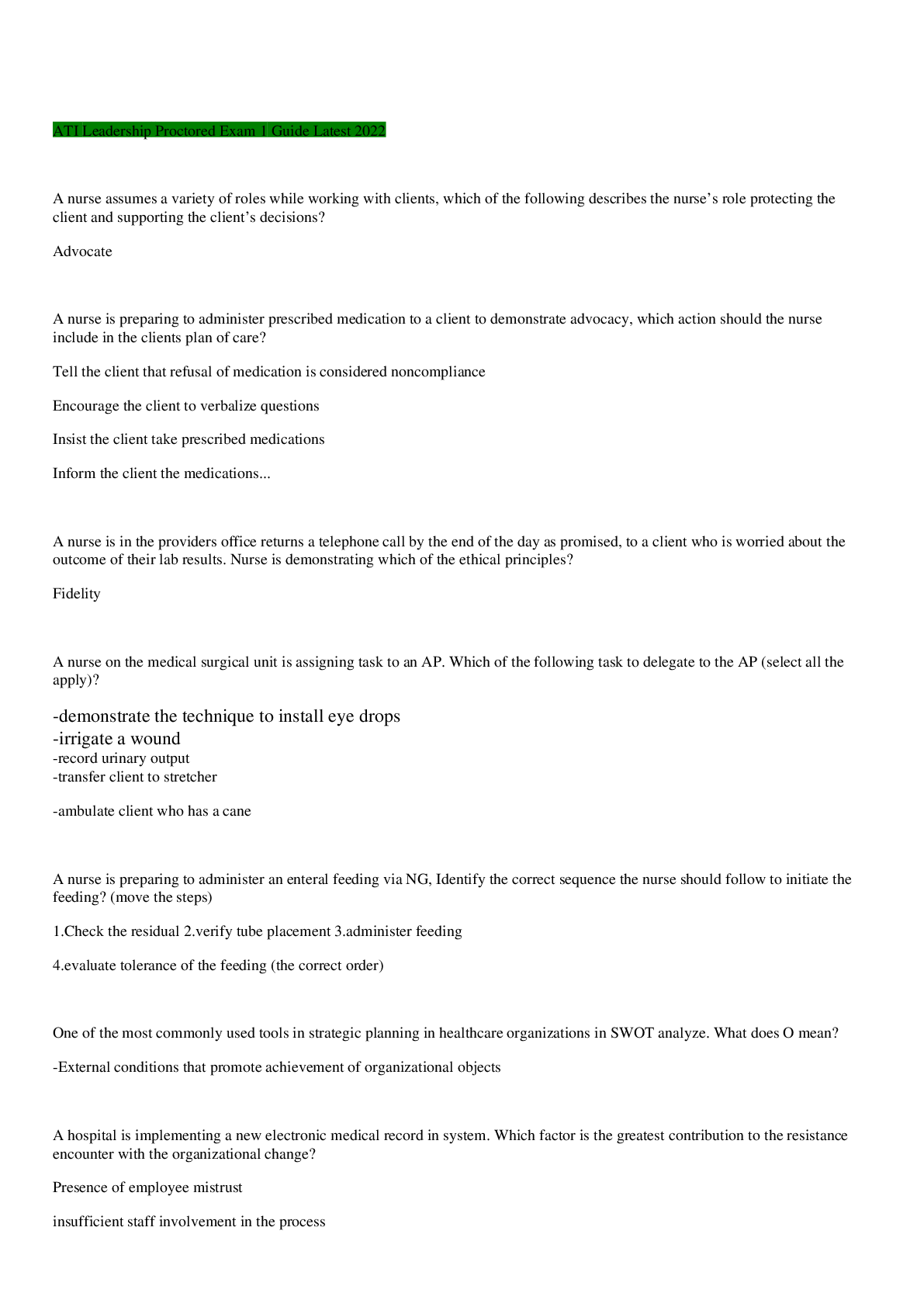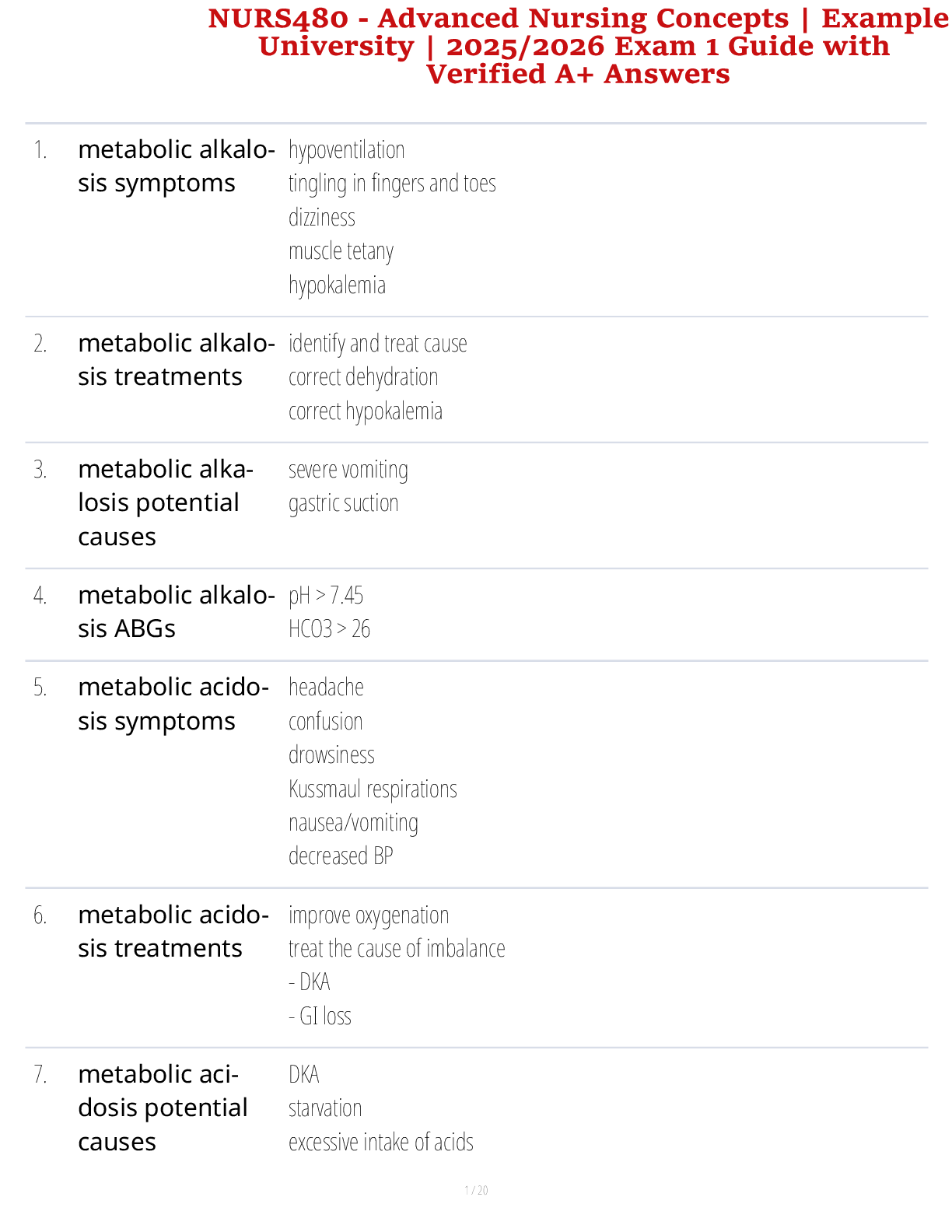*NURSING > STUDY GUIDE > NUR 335 Exam 1 Guide completed A (All)
NUR 335 Exam 1 Guide completed A
Document Content and Description Below
NUR 335 Exam 1 Guide Math 1.Basic dosage Desired/Available * Quantity 2.Formula: IV DROP Rate Volume (mL) Time (min) x Drop Factor (gtts/mL) = Y (Flow Rate in gtts/min) Example: Calculate the ... IV flow rate for 1200 mL of NS to be infused in 6 hours. The infusion set is calibrated for a drop factor of 15 gtts/mL. Volume (mL) Time (min) x Drop Factor (gtts/mL) = Y (Flow Rate in gtts/min) Convert 6 hours to minutes. min ← hr ( x by 60 ) 6 hr x 60 = 360 min 1200 mL 360 min x 15 gtts/mL = 50 gtts/min 3. Formula: IV ml rate Ordered Per Hour Have x Volume (mL) = Y (Flow Rate in mL/hr) Example: Give patient 500 mg of dopamine in 250 mL of D5W to infuse at 20 mg/hr. Calculate the flow rate in mL/hr. Ordered Per Hour Have x Volume (mL) = Y (Flow Rate in mL/hr) 20 mg/hr 500 mg x 250 mL = 10 mL/hr Chapter 1 ****The nursing process includes assessment, diagnosis, planning, implementation, and evaluation A nurses number one job is to make sure the patient and their family understands treatment plans and discharge teachingDomains of Nursing Practice for Medical-Surgical Nursing Certification 1. Helping Role 2. Teaching-Coaching Function 3. Diagnostic and Patient Monitoring 4. Effective Management of Rapidly Changing Situations 5. Administering and Monitoring Therapeutic Interventions and Regimens 6. Monitoring and Ensuring the Quality of Healthcare Practices 7. Organizational and Work Role Competencies Steps of Evidence-Based Practice 1. Develop the question. 2. Search and collate the best evidence. 3. Evaluate the quality of the evidence. 4. Integrate evidence into practice. 5. Evaluate outcomes of practice change. 6. Disseminate the evidence. Evaluating Levels of Evidence 1. Level I Evidence from systematic reviews of randomized controlled studies (RCTs) 2. Level II Evidence from at least one RCT 3. Level III Evidence from quasi-experimental studies 4. Level IV Evidence from case-control and cohort studies 5. Level V Evidence from systematic reviews of descriptive or qualitative studies 6. Level VI Evidence from a single descriptive or qualitative study 7. Level VII Evidence from expert individual authorities or committees National Patient Safety Goals 1. Identify patients correctly 2. Improve staff communication 3. Use medicines safely 4. Use alarms safely 5. Prevent infection 6. Identify patient safety risks 7. Prevent mistakes in surgery The SBAR Approach for Effective Communication SBAR is an acronym that correlates to: Situation: Brief statement of the problem or issue being addressed EX: Hello, Dr. Jones. This is Steve, the registered nurse caring for Ms. Sandra Williams in Room 732 on South Wing. I am contacting you because she arrived from the post-anesthesia care unit (PACU) and has not voided in more than 6 hours. Vitals will be here also Background: Data related to the current situation EX: She was admitted to the hospital this morning, and you performed a lumbar laminectomy this morning for a herniated disc at L4–L5.Assessment: Summary of causes, significance, severity of situation EX:Ms. Williams is complaining of inability to void. According to her operative reports, she received 1,500 mL of IV fluid during the surgical procedure and in the PACU, and the indwelling catheter was removed prior to transfer from the PACU 6 hours ago; at the time, she had 800 mL of urine output. She has received an additional 250 mL of IV fluid since arriving on the unit. Recommendation: Specific actions needed to address the situation EX: I recommend that an intermittent catheterization be performed at this time. Interprofessional practice 1. Provides patient centered care 2. Work in interdisciplinary teams 3. Employ evidence-based practice 4. Apply quality improvement 5. Utilize informatics Interprofessional collaboration Partnership between a healthcare team and the client to make decisions around health and social Issues ADPIE Assessment Diagnosis Planning Implementation Evaluating Patient centered care Effective communication skills Empathy Caring Compassion Hospital Consumer Assessment of Healthcare Providers and Systems (H C A H P S) The Joint Commission (T J C) The Beryl Institute ****Treating patients and families with dignity and respect Involving patients and families in decision making Quality and Safety Education for Nurses (Q S E N) Patient-Centered Care Teamwork and Collaboration Evidence-Based Practice (E B P) Quality Improvement (Q I) SafetyInformatics ****In medical surgical nursing your biggest responsibility is to make sure your patient understands an procedure and they understand their discharge teaching ****The nurse has to have empathy, be caring, and have compassion Chapter 15 Use 18g for IV blood products Always make sure you have consent for everything consent is your biggest responsibility (Surgeon gets consent) Make sure patient understands the procedure and everything that follows. Make sure that the patient has no questions (Nurses responsibility) They need to know the doctors name Informed Consent Components include: Consent for procedure itself Name of surgeon to perform surgery Reason intervention will benefit the patient Alternative options to surgery Consent for anesthesia Consent to administer blood products ***Although obtaining consent is not the role of the nurse but that of the provider, it is the nurse’s responsibility to ensure that the patient has all the information needed to make an informed decision about the procedure being offered Obtaining Consent The role of the surgeon is to obtain consent for the procedure. The surgeon is solely responsible for obtaining consent in the presence of the patient and one witness. The role of the preoperative nurse is to clarify information and ensure patient understanding. Nurses correct common misconceptions and ease concerns of the patient, family members, or support persons Advanced Directives Defines patient’s wishes Name a power of attorney SurgeryCorrect patient Correct procedure Correct Surgical Site *** Always remember my right may be your left and your left may be my right she make sure your on the correct side Always assess patients Their medical history is important( always ask about bleeding problems) Make sure patients has understanding of how to use assistant devices incase needed Surgical and anesthesia history Do you have poor healing, any pervious surgeries, negative responds to anesthesia, or any allergies ***If allergies put on alert bracelet Last oral intake Guidelines dependent upon institution and population Full stomach increases risk for aspiration ***A patient who has eaten within 8 hours is at risk of aspiration, the introduction of food particles into the lungs through emesis ***According to recent guidelines for elective procedures, the patient may be advised to be NPO 6 to 8 hours for solid foods and 2 hours for clear fluids. Physical preparations Intravenous line An IV line is inserted during the preoperative admission, typically for the purpose of the administration of anesthesia and fluids during the surgery. An 18-gauge catheter is preferred because this size is required for the administration of all blood products. Bowel and bladder preparation Patients receiving abdominal, intestinal, gynecological, or rectal surgery may be asked to perform a bowel preparation. This may be done by use of an enema or gentle laxatives that the patient self-administers at home the night before the procedure. The nurse should confirm and document that this preparation has been performed. Patients scheduled for abdominal, gynecological, or long procedures may also require the insertion of an indwelling catheter to drain urine. This will keep the bladder empty during a procedure, preventing injury to the bladder. It also allows the surgical team to monitor output in the operating room and PACU. Skin preparation Prior to surgery, skin preparation is done to help prevent infection at the surgical site. Patients may be instructed to shower and wash with Betadine or hexachlorophene soap prior to admission. A surgical shave may be necessary depending on the patient’s skin type and the location of the incision. If a shave is appropriate, the nurse uses a sterile electric clipper. A razor is not recommended because of the risk of infection caused by small nicks in the skin that may occur with a razor. Medications Preoperative medications may be required. Patients with preoperative anxiety may be prescribed a benzodiazepine such as midazolam HCl, diazepam, or lorazepam. Antiemetics such asmetoclopramide HCl or ondansetron HCl may be used preoperatively if a patient has a history of nausea and vomiting due to anesthesia. Medications You need to know if the patient takes any medications or herbal medications 3’G’s Ginger. Ginkgo Biloba, Garlic Taking anticoagulants Priority assessments Cardiovascular Respiratory Integumentary Priority labs CBC PTT/INR You want to try to prevent DVT (DVT Prophylaxis)- Sequential compression devices Prevent Pneumonia- Incentive Spirometer(Inhale than breathe out) use at least 10 in an hour Also do deep breathing and coughing Always remove jewelry and prosthetics before surgery ****Patient teaching is very important they should verbalize and demonstrate their understanding Chapter 16 Impatient- Require close monitoring and recovery more than 24 hours after completion Same day- Require less than 24 hours of monitored recovery Elective Surgery- The patient Chooses Urgent Surgery- May not be up to the patient ***The patient has the right to deny any produce Table 16.1 Suffixes for Surgical Procedures Suffix Meaning Examples -centesis Puncture Amniocentesis, thoracentesis -ectomy Removal Cholecystectomy, hysterectomy -lysis Destruction Electrolysis -oscopsy View with scope Arthroscopy, endoscopy***Make sure the patient understands and consents to everything Sterile team members Surgeon Surgical assistants Scrub nurse or surgical technologist Nonsterile team members Anesthesia provider Circulating R N Unlicensed assistive personnel O R director/coordinator/manager Surgical pause Correct patient Correct procedure Correct surgeon Correct position Correct equipment Correct imaging studies Hand Washing Scrub hands for 3-5 min Remove jewelry Make sure nails are cut, short, and clean Donning Hand hygiene Gown Mask Goggles Gloves Removing Gloves Goggles Gown Mask Hand hygiene -ostomy Create an opening Colostomy, ileostomy -otomy Incision Episiotomy, tracheotomy -plasty To reshape or repair Abdominoplasty, mammoplasty***Everything has to be above the waist to be sterile General anesthesia Being put to sleep Reversible unconscious state Variety of methodologies Volatile agents I V agents Muscle relaxants Complications Hypoxia(Low oxygen) Hypotension(low blood pressure) Hypertension(High blood pressure) Residual muscle paralysis(Weakness) Malignant hyperthermia(fast rise in body temp) Regional anesthesia Spinal Epidural Caudal Nerve block Objectives Maintenance of consciousness *Elevation of pain threshold Enhanced cooperation Some degree of amnesia *Minimal variation in vital signs *Quick and safe return to activities of daily living Airway management Protecting and ensuring proper oxygenation and ventilation Complications: o Laryngospasm o Bronchial intubation o Tracheal and esophageal perforation o Aspiration PositionsSupine Prone Lateral Lithotomy ***Patient education is important and making sure family is updatedChapter 6 65-75: young old 75-85: old Older than 85: old old Age related changes Senescence – Normal age-related changes in organ systems *Sclerosis – Hardening of tissue due to fibrous tissue overgrowth Stenosis – Narrowing or constricting of a passage or orifice *Atrophy – Wasting away or decrease in the size of an organ *Calcification – Calcium and calcium salts are deposited in abnormal locations, like blood vessels Risk factors Cardiovascular problems Stoke Hypertension High cholesterol Diabetes Smoking Obesity Poor Diet Physical activity Common Illnesses Pneumonia – Older adults at higher risk due to decrease in lung’s elastic recoil, weakened cough reflex, weakened diaphragm strength, and impaired swallowing Chronic obstructive pulmonary disease – Smoking is greatest risk factor Dementia – Progressive cognitive decline that affects a person’s social and occupational functioning Depression – Difficult to diagnose in older adults and may include low energy levels, difficulty sleeping, less appetite, aches and pains, difficulty remembering details Parkinson’s disease – Degenerative condition primarily affecting movement, causing tremor, rigidity, gait disturbance, and speech disturbance Cerebrovascular accident – Stroke; vascular disease manifesting as paralysis, weakness, speech and vision impairment Episodic memory diminishes with age – Evident in tasks requiring learning and recall of items that are not meaningful, for example, phone numbers Free recall diminishes – The ability to recall unrelated words from a list decreasesWorking memory ability decreases – The ability to multitask successfully declines with aging, along with reduced ability to process complex incoming information Semantic memory maintained or may increase – Memory of facts and meanings and intellectual ability are unchanged Processing speed decreases – If speed is not crucial, information is retrieved as well as in younger people Increased risk of dehydration General decline in bladder function and capacity. Sexual dysfunction related to hormone decreases, organ atrophy, and decreased sexual fluids Senses of taste and smell diminish, making food seem less appealing Premature feelings of fullness leading to malnutrition Constipation and impaction Dentition/chewing limiting available foods Dysphagia leading to aspiration or pocketing of food ***Delirium- Is a quick onset of confusion ***Dementia- Slow and progressive over time Always ask about medications and what and when are they taking these meds Polypharmacy- Taking any and everything not really knowing what it is You want to protect them from abuse and watch for S&S Ask about their living will and do they have an DNR Medicaid- Medical coverage to low income families. The state and government share the cost Medicare- Is very important to elderly. Is a federal program that provides health care to people 65+ Part A(Hospital Insurance) – Covers inpatient hospital stays Part B(Medical insurance)- Covers doctors services Part C- Private companies that cover what part A and B don’t Part D(Prescription)- Covers medication cost ***Some parts some people can’t get *** When you document you want to watch what you put in when it comes to Medicare *** Always remember safety is a priority with elderly ***Everything decreases but blood pressure Chapter 8 Intracellular fluid (ICF) – about two thirds by volume, contained in cells Extracellular fluid (ECF) – consists of two major subdivisions Plasma – the fluid portion of the blood Interstitial fluid (IF) – fluid in spaces between cells 2500 ml/ day in so 2500ml/ day out Whatever the patient takes in it needs to come outUrine output 1500mL / 30ml/hr Osmosis-Low concentration to high concentration Diffusion- High concentration to low concentration Fluid Spacing First spacing normal distribution of fluids in the ICF & ECF compartments Second spacing abnormal accumulation of interstitial fluid as seen in edema Third spacing accumulation of fluid in portions of the body which is not easily exchanged with the rest of the ECF Regulates Water Balance Hypothalamic Pituitary Release of ADH Increase in plasma osmolality or decrease in blood volume will stimulate thirst and the release of ADH Signs and Symptoms of Diabetes Polyuria: LOTS of urine 4L to 24 L per day Polydipsia: body’s way of trying to keep water in the body….crave water/ice Dry mucous membranes, dry skin, decrease skin tugor…very dehydrated Urine diluted….low urinary specific gravity Hypotension (due to the severe dehydration and remember ADH is responsible for constricting blood vessels…here the vessel will be dilated which causes hypotension) Extreme fatigue and muscle pain/weakness Hypernatremic (due to the concentrate sodium in the body from low water levels) Solutions Isotonic(NO CHANGE) No change in the concentration of solute and water in the bloodstream Osmosis neither moves water into the circulation nor pulls it out. 0.9 NACL ; LR; D5W (functions as hypotonic once glucose is metabolized) Treatment for ECF deficits – expands ECF volume Hypotonic(BIG CELLS) Lower osmolality than blood serum More water (relative to solute) is being infused than is already present in the vessel and inside the cells. Therefore, water moves into the cells Indicated for hypernatremia and hyperosmolar conditions Replaces cellular fluid & provides free water Can cause cerebral edema and Hypotension from intravascular depletion Contraindicated in edema and third spacing 0.45 NS (1/2 NS) , D5 .45 Hypertonic(SMALL CELLS) Higher osmolality than blood serum Osmosis pulls water out of the cells Cell shrinkage Increased osmolality of ECF - expands it Indications: Hyponatremia 3% NACL, D10W, D50W Plasma Volume Expanders Stays in the intravascular compartment and increases oncotic pressure Colloids Protein solutions - albumin (5% or 25%) Synthetic molecules - Dextran, Hespan (Hetastarch) Whole blood or packed red blood cells [PRBCs] **Indicated for fluid losses from ECF (hemorrhage or sepsis) Edema(Swelling)2mm or less = +1 Slight pitting, No visible distortion, Disappears rapidly 2-4mm = +2 Somewhat deeper pit, No readably detectable distortion, Disappears in 10-15 seconds 4-6mm = +3 Pit is noticeably deep, May last more than 1 minute, Dependent extremity looks fuller and swollen (4- 6mm) 6-8mm = +4 Pit is very deep, Lasts as long as 2-5 minutes, Dependent extremity is grossly distorted (6-8mm) Daily Weight Single most important measurement for fluid volume status Same time, same scale, same clothing 1L = 1kg = 2.2lbs 1 L (2.2 lbs) = 1 liter of fluid (lost or retained) Hypervolemia( increased water and sodium) Causes Increased water and sodium retention Cirrhosis Heart failure Stress conditions Use of corticosteroids Sodium intake Clinical manifestations Weight gain Ascites Edema Increased urine output Cardiac symptoms Respiratory symptoms Medical management Correcting and managing underlying cause Treating clinical manifestations Fluid restriction Discontinue I V fluids Diuretics Dialysis( to remove fluid out of body) Complications Pulmonary edema Nursing management Collecting health history Physical assessment Reviewing laboratory data Monitoring weight Calculating I&O Hypovolemia Order 0.9 NaCI Laboratory values Electrolytes Hemoglobin and hematocrit Serum osmolality BUN and creatinine Urine specific gravity Urine osmolality Clinical manifestations Weight loss Decreased skin turgor Concentrated urine output Oliguria<30 mL per hour Thirst Dry mucous membranes Medical management Identify and treat cause Intake of oral fluids IV isotonic solutions Close monitoring Complications Hypovolemic shock Hypotensin Tachycardia Signs of organ hypoperfusion Nursing management Collection of health history Physical assessment Vital signs Mucous membranes, skin turgor Urine specific gravity, color, volume I&O Sodium 135-145 Hyponatremia(low sodium) Causes Medications (diuretics) Diarrhea or vomiting Hyperglycemia with glucosuria Perspiration S I A D H Hypothyroidism Adrenal insufficiency Psychotic polydipsia Heart failure Cirrhosis Nephrotic syndrome Clinical manifestations Related to cerebral edema and neurological decline, Lethargy, Headache, Confusion, Gait disorders, Nausea and vomiting, Seizure, coma, permanent brain damage, death if not treated Nursing management Monitor I&O, Ensuring adequate water intake, Monitor daily weight, Monitor serum sodium, patient education Complications Lethargy, Confusion, Weakness, Fatigue, Muscle cramps, Postural hypotension, Severe: Seizure, coma, death : Replacement of sodium, Oral, enteral, parenteral, Fluid restriction, Hypertonic saline if neuro involvement Diuretics. Hypernatremia(High Sodium) Causes Reduced water intake Limited ability to express thirst Diabetes insipidus Hyperglycemia Neoplasms Hypercalcemia Hyperkalemia Medications Clinical manifestations Nonspecific neurological changes Neuromuscular irritability, agitation, restlessness, lethargy, coma, seizure Severe: hallucinations, delusions, disorientation Thirst Signs of dehydration Medical management Limiting sodium intake Replacing water deficits Complications Restlessness Weakness Disorientation Delusions Hallucinations Severe: Seizures, stupor, coma, death Nursing management Monitor I&O Ensuring adequate water intake Monitor daily weight Monitor serum sodium Potassium 3.5-5.0 Hypokalemia(low potassium) Clinical manifestations Weakness Lethargy Hyporeflexia Nausea/vomiting Constipation Abdominal cramping Electrocardiogram changes: ST depression Severe: Cardiac or respiratory arrest Medical management Potassium supplementation Cardiac monitoring Intravenous access Complications Muscle weakness and cramping Decreased G I motility Cardiac dysrhythmias Respiratory failure Cardiac or respiratory arrest Death Nursing management Assessment Monitor digitalis levels if applicable Patient education Administer potassium replacement***Needs to be on telemetry floor They have ventricular dysrhythmias > Ventricular fibrillation Never push Potassium Hyperkalemia(To much potassium) Clinical manifestations Generalized fatigue Muscle cramps Palpitations Paresthesias Weakness E C G changes Cardiac arrest Medical management Obtain E C G Serial serum potassium levels, Loop diuretics Dialysis Dietary modification Correction of metabolic acidosis Complications Nausea and diarrhea Muscle weakness Cardiac dysrhythmias Cardiac arrest DeathNursing management Assessment Monitoring and reporting lab values Continuous cardiac monitoring and E C G Administer medications as ordered Patient education *** T wave peak, ST depression, QT shorten Calcium 8.2-10.2 Positive Trousseau sign. With inflation of the blood pressure cuff, the fingers go into carpal spasm, indicating hypocalcemia. Chvostek sign. Tapping over the facial nerve leads to twitching of the face related to hyperexcitability of the neuromuscular junction due to hypocalcemia. Hypocalcemia(To little Calcium) Less than 6.5 Clinical manifestations Excitability of nerves and muscles Smooth muscle spasms Prolonged Q T interval Decreased myocardial contractility Anxiety, confusion, irritability Positive Trousseau and Chvostek sign Medical management Protection and maintenance of airway Cardiac monitoring I V access I V replacement of calcium Treat other electrolyte abnormalities, especially magnesium Oral calcium and vitamin D supplements Complications Cardiovascular collapse Refractory hypotension Laryngospasm Dysrhythmias Decompensated heart failure Nursing management Assessment Maintain access to emergency equipment Seizure precautions Maintain quiet environment Patient education Encourage smoking cessation Encourage limiting caffeine and alcohol *** Use calcium gluconate with D5W/ 0.5mg/kg/hr IV IN D5W *** Re-evaluation of serum calcium levels should be done every 4 to 6 hours during replacement therapy to prevent hypercalcemia Hypercalcemia(To much Calcium) Clinical manifestations Bradycardia, Hypertension Thirst, Lethargy Muscle weakness and soreness, Abdominal discomfort Constipation, Decreased deep tendon reflexes, Anorexia, Nausea, vomiting Lethargy, Confusion, Renal calculi and renal failure, bone pain Medical management Stabilization and reduction of calcium levels Hydration with 0.9% NaCl Dialysis I V biphosphates Calcitonin Treatment of malignancy Removal of parathyroid gland Complications Cardiac rhythm changes T-wave changes Heart block Cardiac arrest Confusion Lethargy Coma Nursing management Assessment and monitoring Cardiac rhythm Mental status Encourage early and frequent ambulation Encourage hydration *** Number one thing they present with is Joint and bone pain *** You give 0.9% NaCI *** They need lots of fluids to rid the body of the extra calcium ***Maintain urine output 100-150ml/hr *** Doctor will order Bisphosphates Extra Notes ****Remember BMP is Basic Metabolic PanelEKG Wave CBC Values WBC 4,500-11,000 PLT -140,000-450,000 RBC- Male 4.5-5.5 Female 4-4.9 Hgb- Male 13.5- 16.5 Female 12-15 HCT- Male 41- 50 Female 36-44 Other levels Mg- 1.6-2.2 Cl- 97- 107 P- 2.5-4.5 ABG’s (Arterial Blood Gas) [Show More]
Last updated: 2 years ago
Preview 1 out of 23 pages

Buy this document to get the full access instantly
Instant Download Access after purchase
Buy NowInstant download
We Accept:

Reviews( 0 )
$15.00
Can't find what you want? Try our AI powered Search
Document information
Connected school, study & course
About the document
Uploaded On
May 16, 2021
Number of pages
23
Written in
Additional information
This document has been written for:
Uploaded
May 16, 2021
Downloads
0
Views
94


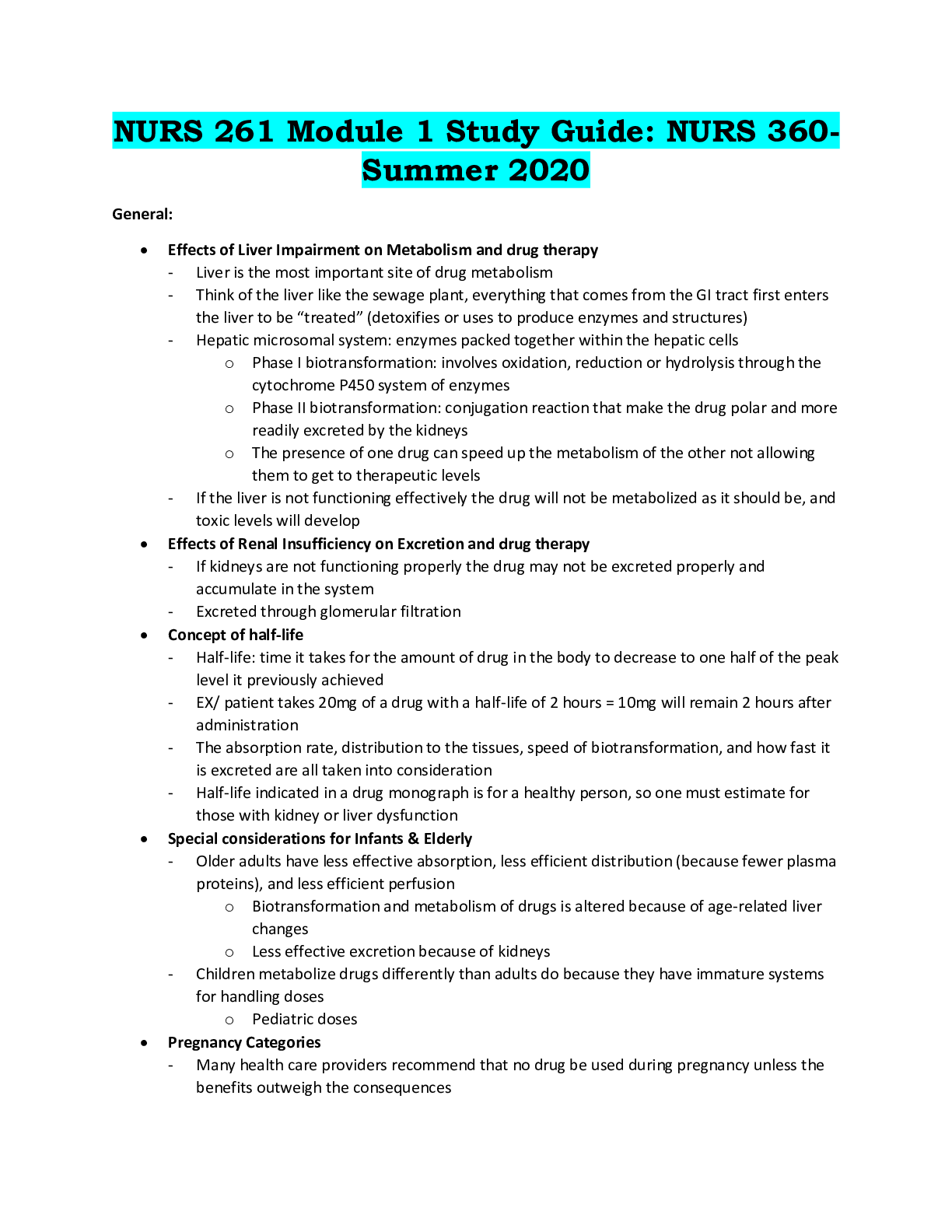

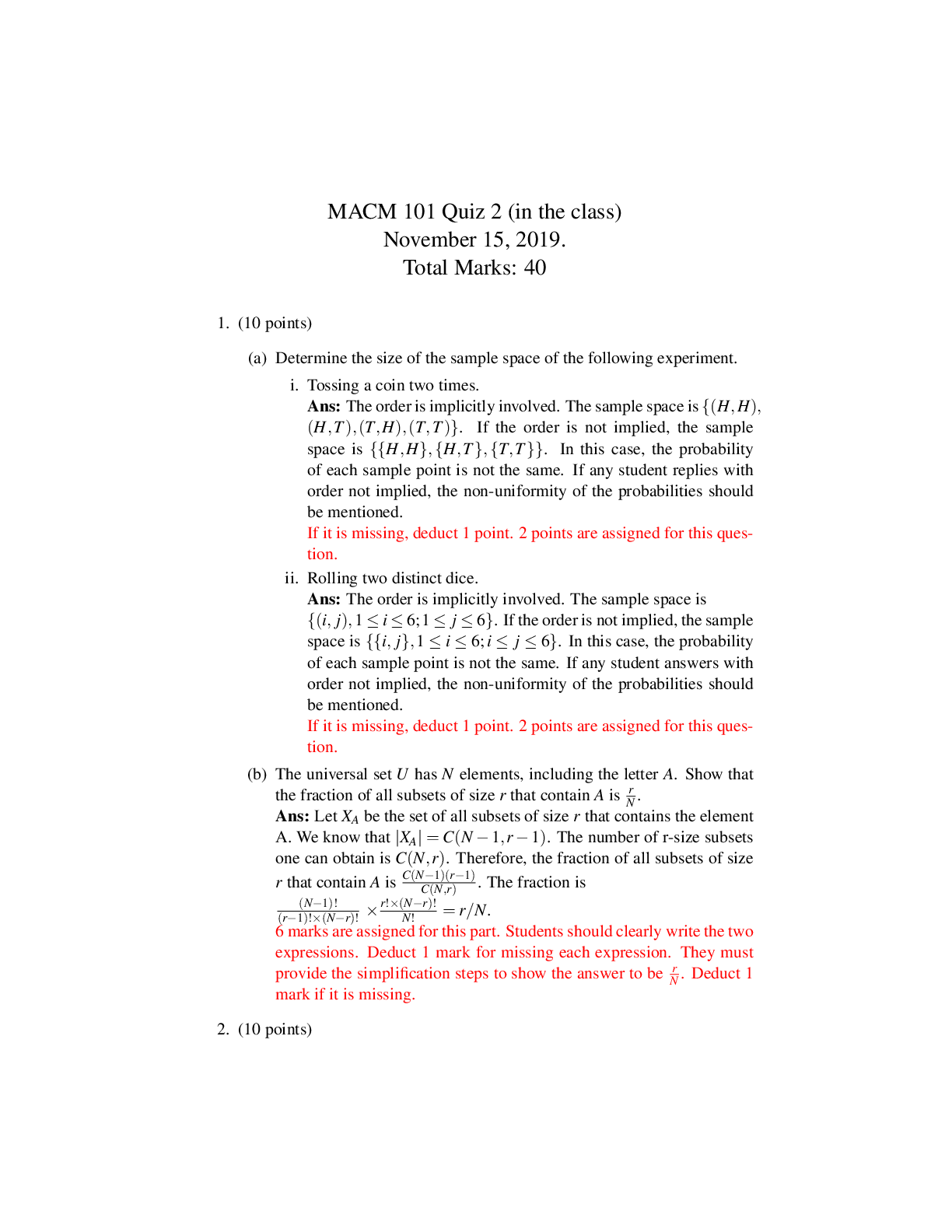

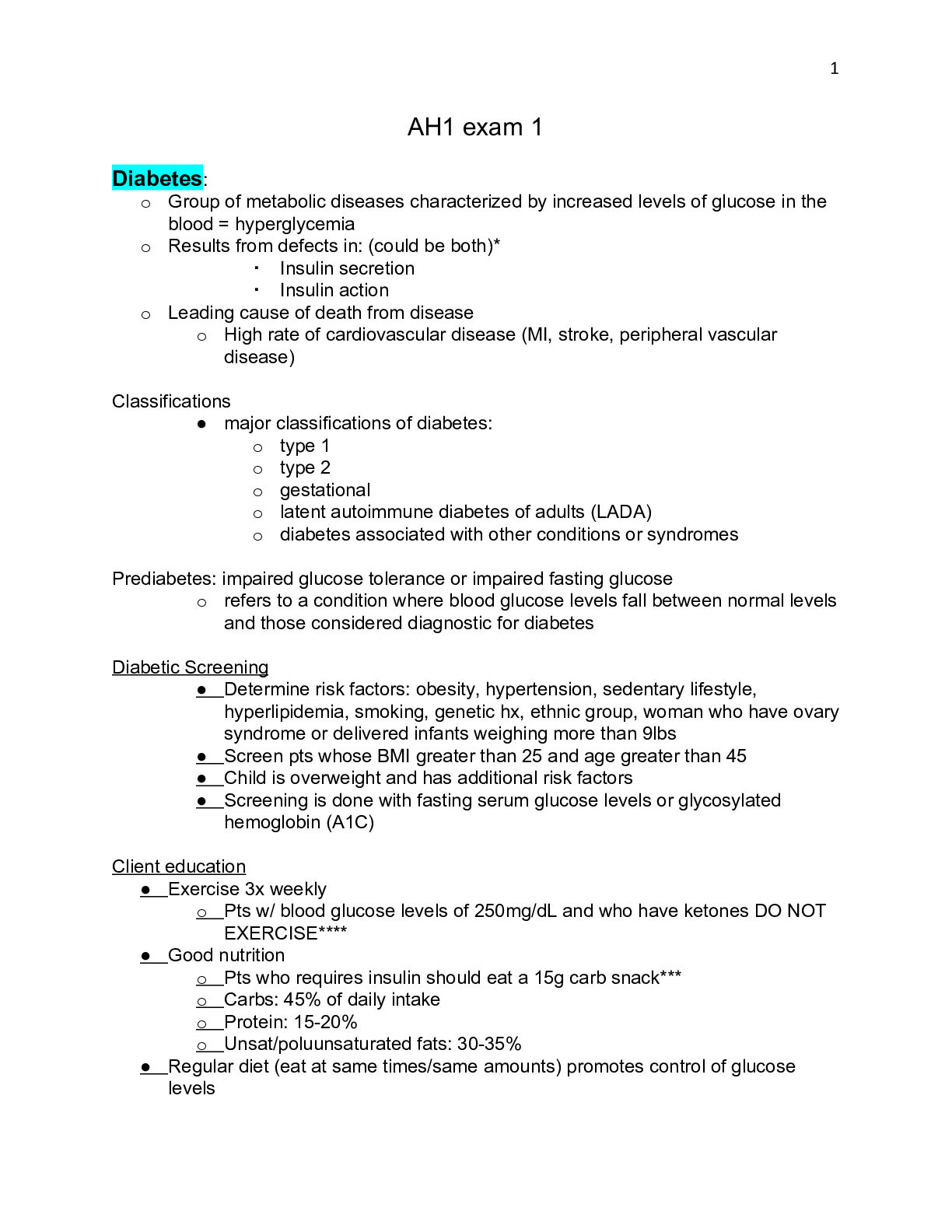
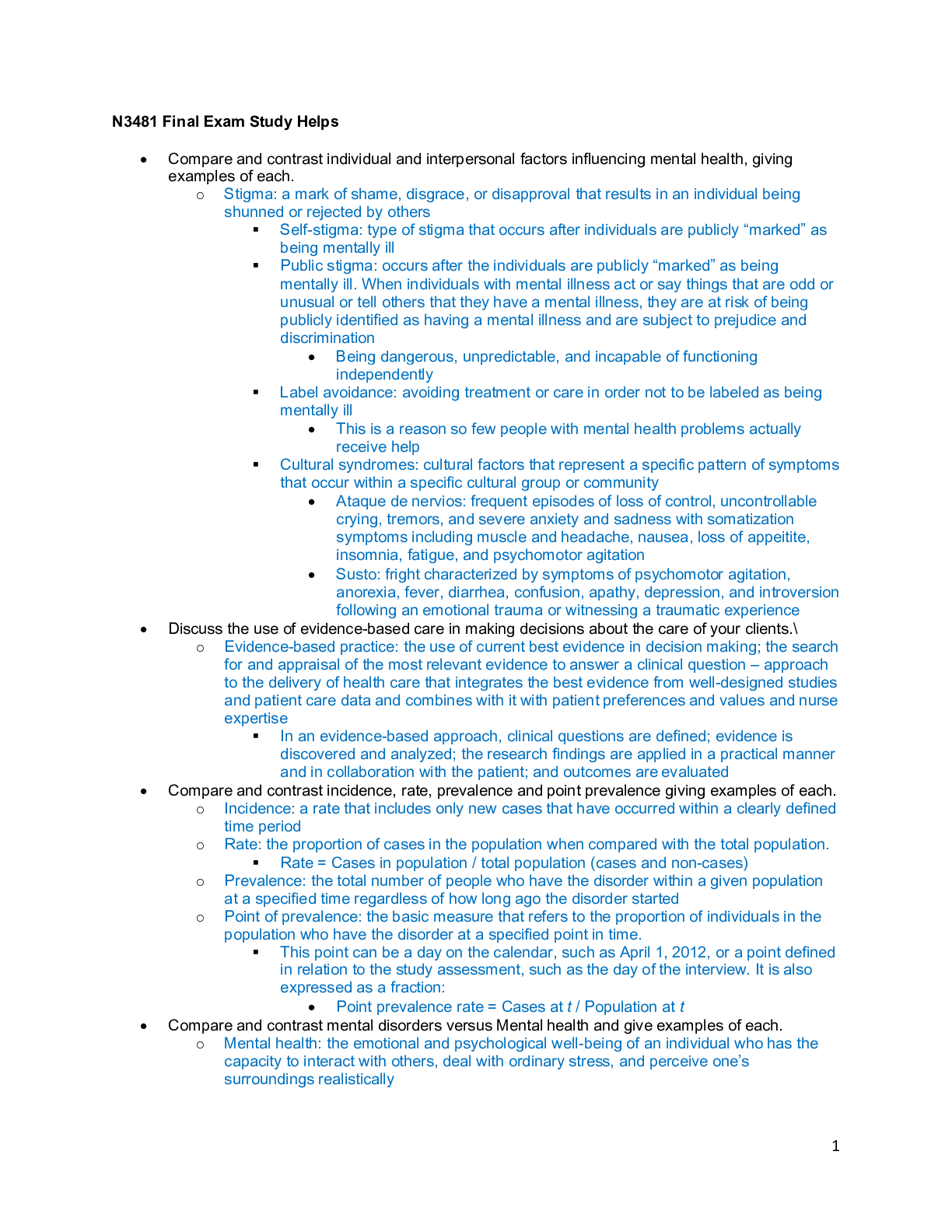

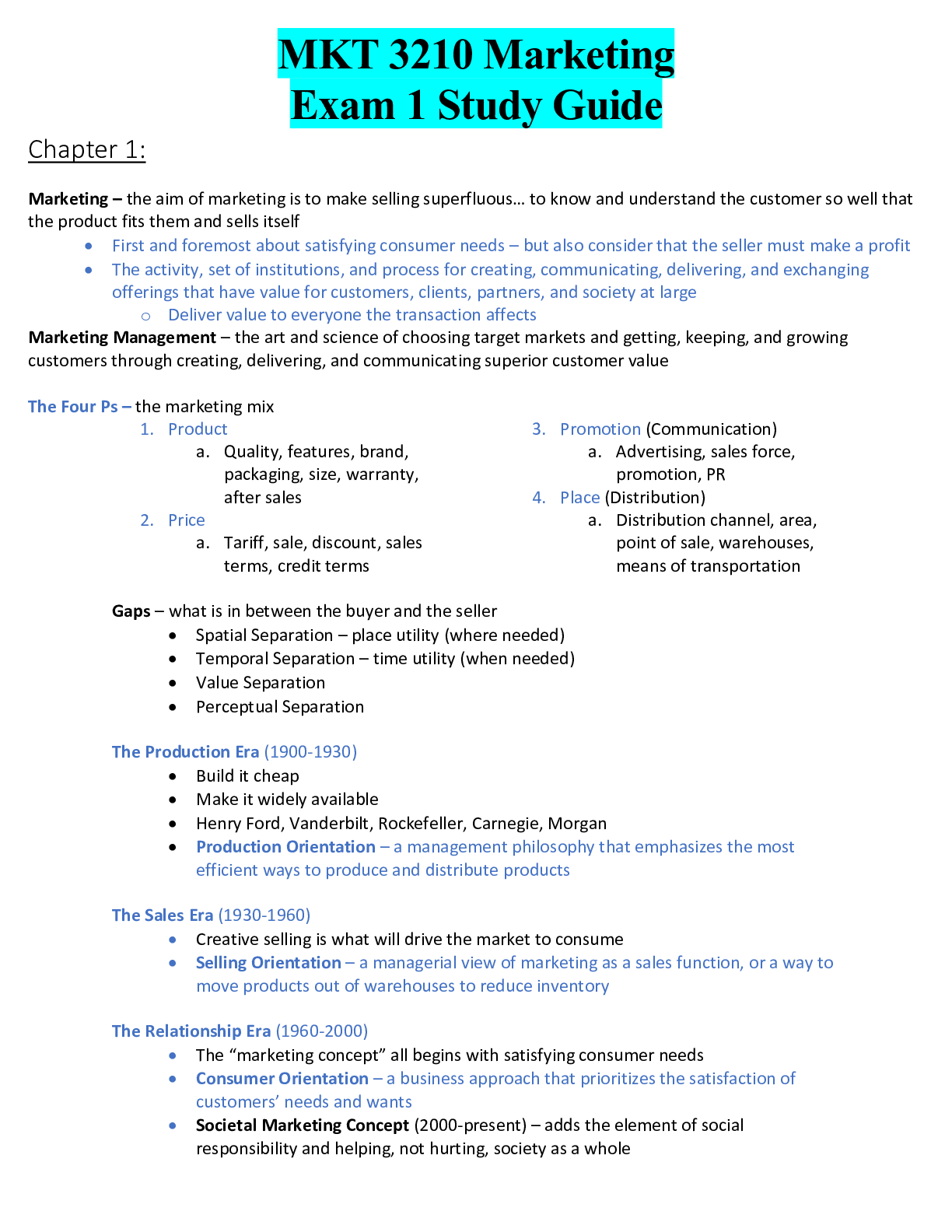



.png)




